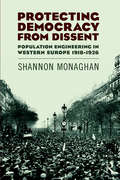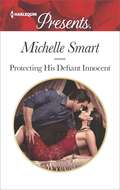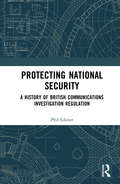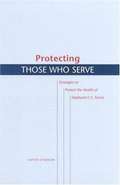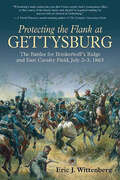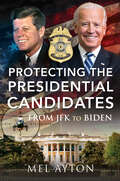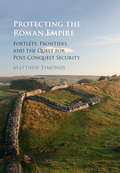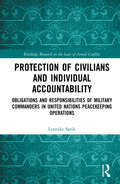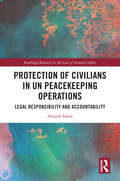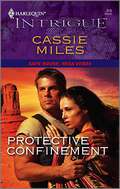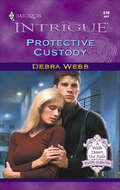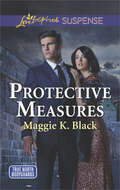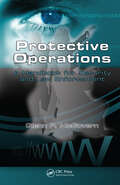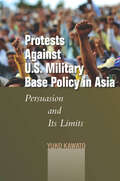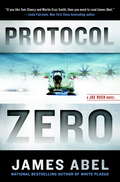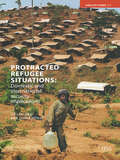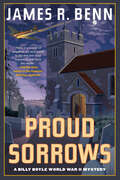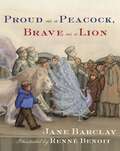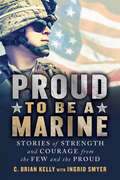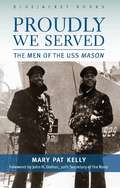- Table View
- List View
Protecting Democracy from Dissent: Population Engineering In Western Europe, 1918-1926 (Routledge Studies in Modern European History)
by Shannon MonaghanIn the aftermath of the First World War, the victorious powers – more or less liberal democracies – argued that democracy would bring peace to Europe because this was the only effective way for legitimate states, with governments based on the consent of the governed, to be organized. What the victorious statesmen failed to foresee was how much conflict this postwar settlement would provoke, since it was far from clear exactly which people should qualify for the privilege of self-governance. It is well known that these conflicts played out dramatically and violently in eastern and southeastern Europe in the immediate postwar years. What is less well known is that the contest extended into the western European heartland of the victorious powers as well. There, the quest for a new conception of democracy – based on both liberalism and nationalism – led the victors to pursue liberal policies of population engineering with, paradoxically, the best of intentions: the preservation and stability of democracy itself. In an era in which people were becoming more involved in choosing their governments, governments were becoming more involved in choosing their people. While the victors sought to craft a more ethical – or at least more legalistic – form of population engineering than the often violent and ad hoc versions employed further east, the result nevertheless remained at odds with the ethical foundations of liberal democracy.
Protecting His Defiant Innocent: An Uplifting International Romance (Bound to a Billionaire)
by Michelle SmartTempted by her billionaire protector… Traveling to a dangerous Caribbean island to continue her late brother’s charitable work, Francesca Pellegrini finds herself under the protection of security tycoon Felipe Lorenzi. Independent Francesca is infuriated by his commands, but Felipe’s every look invites her to give up her innocence to him…With his body and heart as hard as stone after his military career, Felipe has no time for Francesca’s seductive games. Until this captivating young woman entices him beyond all measure, and this lone wolf decides to throw away his strict rules and take her as his own!
Protecting His Witness (Cavanaugh Justice #13)
by Marie FerrarellaUndercover police officer Zack McIntyre couldn't make sense of the beautiful, mysterious stranger who had saved him from death. She cared for him with skilled, gentle hands, awakening passions within him, but her haunted eyes spoke of secrets, lies and terrible fear. And he knew he couldn't rest unless he kept her safe from harm-and made her his own.Endless months in the shadows, hiding from a killer, had taught Dr. Krystle Maller to trust no one. This strong, compelling man made her long to take shelter, just for a little while, in the circle of his arms. But could she trust even him with her deadly secret?
Protecting National Security: A History of British Communications Investigation Regulation
by Phil GloverThis book contends that modern concerns surrounding the UK State’s investigation of communications (and, more recently, data), whether at rest or in transit, are in fact nothing new. It evidences how, whether using common law, the Royal Prerogative, or statutes to provide a lawful basis for a state practice traceable to at least 1324, the underlying policy rationale has always been that first publicly articulated in Cromwell’s initial Postage Act 1657, namely the protection of British ‘national security’, broadly construed. It further illustrates how developments in communications technology led to Executive assumptions of relevant investigatory powers, administered in conditions of relative secrecy. In demonstrating the key role played throughout history by communications service providers, the book also charts how the evolution of the UK Intelligence Community, entry into the ‘UKUSA’ communications intelligence-sharing agreement 1946, and intelligence community advocacy all significantly influenced the era of arguably disingenuous statutory governance of communications investigation between 1984 and 2016. The book illustrates how the 2013 ‘Intelligence Shock’ triggered by publication of Edward Snowden’s unauthorized disclosures impelled a transition from Executive secrecy and statutory disingenuousness to a more consultative, candid Executive and a policy of ‘transparent secrecy’, now reflected in the Investigatory Powers Act 2016. What the book ultimately demonstrates is that this latest comprehensive statute, whilst welcome for its candour, represents only the latest manifestation of the British state’s policy of ensuring protection of national security by granting powers enabling investigative access to communications and data, in transit or at rest, irrespective of location.
Protecting THOSE WHO SERVE: Strategies to Protect the Health of Deployed U.S. Forces
by Committee on Strategies to Protect the Health of Deployed U.S. ForcesSince the Gulf War ended in 1991, various constituencies, including a significant number of veterans, speculate that unidentified risk factors led to chronic, medically unexplained illnesses, and these constituencies challenge the depth of the military’s commitment to protect the health of deployed troops. Despite general concurrence in findings to support these claims, few changes have been made at the field level. The most important recommendations remain unimplemented, despite the compelling rationale for urgent action. Protecting Those Who Serve illuminates these recommendations and government-developed plans that remain inactive due to a lack of authority within the Department of Defense, while describing the dangers that may result from failure to protect our forces in the field.
Protecting the Flank at Gettysburg: The Battles for Brinkerhoffs Ridge and East Cavalry Field
by Eric J. WittenbergAn account of Gettysburg campaign of 1863, that witnessed a showcase of the talents and where the mounted fighting made lasting contributions to the battle, the campaign, and the history of the American cavalry.
Protecting the Flank at Gettysburg: The Battles for Brinkerhoff’s Ridge and East Cavalry Field, July 2 -3, 1863
by Eric J. WittenbergThe award-winning Civil War historian’s study “makes the case that Union cavalry had a tremendous effect on the course of the titanic battle” (J. David Petruzzi, author of The Complete Gettysburg Guide).On July 3, 1863, a large-scale cavalry fight was waged on Cress Ridge four miles east of Gettysburg. There, on what is commonly referred to as East Cavalry Field, Union horsemen under Brig. Gen. David M. Gregg tangled with the vaunted Confederates riding with Maj. Gen. Jeb Stuart. This magnificent mounted clash, however, cannot be fully appreciated without an understanding of what happened the previous day at Brinkerhoff’s Ridge, where elements of Gregg’s division pinned down the legendary infantry of the Stonewall Brigade, preventing it from participating in the fighting for Culp’s Hill that raged that evening.After arriving at Gettysburg on July 2 and witnessing the climax of the fighting at Brinkerhoff’s Ridge, Stuart knew that if he could defeat Gregg’s troopers, he could dash thousands of his own men behind enemy lines and wreak havoc. The ambitious offensive thrust resulted the following day in a giant clash of horse and steel on East Cavalry Field. The combat featured artillery duels, dismounted fighting, hand-to-hand engagements, and the most magnificent mounted charge and countercharge of the entire Civil War.This fully revised edition of Protecting the Flank at Gettysburg is the most detailed tactical treatment of the fighting on Brinkerhoff’s Ridge yet published, and includes a new Introduction, a detailed walking and driving tour with GPS coordinates, and a new appendix refuting claims that Stuart’s actions on East Cavalry Field were intended to be coordinated with the Pickett/Pettigrew/Trimble attack on the Union center on the main battlefield.
Protecting the Presidential Candidates: From JFK To Biden
by Mel AytonProtecting the Presidential Candidates is the first book of its kind to examine how presidents and presidential candidates were protected during the presidential election cycles – from JFK to Biden. It is also the first book of its kind to tell the story of the role of state troopers and private bodyguards in protecting presidential candidates. Protection for candidates changed and evolved from the free-wheeling style of the 1950s and early 1960s, which afforded presidential candidates little or no protection, to the growth of bodyguard personnel, increased intelligence facilities and state of the art technology employed today to keep the candidates safe. Presidential candidates relish connecting with the public and it has given greater visibility to the bodyguards who are willing to place themselves between a presidential candidate and a would-be attacker. In the milieu in which the Secret Service operates, bodyguards have witnessed the terrors of election campaigns when presidential candidates have waded into crowds to shake hands with their supporters, rode in open-top cars, and made sudden but risky changes to their schedules – oblivious to the fact that in every campaign there have been people stalking candidates with ill intent. Many stories revealed in Protecting the Presidential Candidates have remained largely hidden from the public; some buried in newspaper archives and others in oral histories, presidential libraries or official government documents. The author draws on numerous sources, including FBI files, presidential biographies, vice presidential biographies, civilian bodyguard memoirs, Secret Service agent memoirs, White House staff memoirs and more so that these stories can now be told. The book also allows readers to gain an insight into the personal as well as professional relationships between the candidate and the bodyguards who protected them. Some candidates were so trusting of their bodyguards they embraced them as part of an ‘inner circle’ of advisers. Bodyguards have also witnessed embarrassing moments in a candidate’s campaign and how intrusive they have been at the most delicate of moments. "The president’s day is your day," one agent said. "Nobody sees the president the way an agent does."
Protecting the Princess (Wild West Bodyguards #1)
by Carla CassidyPrincess Anna thought cowboys were the stuff ofmovies, but rugged, gunslinging Tanner West wasliving, breathing proof they existed. Just like shewas a very real damsel in distress after her father'skingdom was overthrown and rebels wanted herdead. Her father had claimed Tanner was the onlyman who could protect her, but could he shieldher from falling dangerously in love?Tanner West thought he'd seen it all, but aprincess in Oklahoma with assassins on her—high—heels? He was more worried the spoiledroyal wouldn't survive a day on his family's rusticranch. He would risk his life to make sure hisprincess lived happily ever after, but would thatmean risking his heart, too?
Protecting the Roman Empire: Fortlets, Frontiers, and the Quest for Post-Conquest Security
by Matthew SymondsThe Roman army enjoys an enviable reputation as an instrument of waging war, but as the modern world reminds us, an enduring victory requires far more than simply winning battles. When it came to suppressing counterinsurgencies, or deterring the depredations of bandits, the army frequently deployed small groups of infantry and cavalry based in fortlets. This remarkable installation type has never previously been studied in detail, and shows a new side to the Roman army. Rather than displaying the aggressive uniformity for which the Roman military is famous, individual fortlets were usually bespoke installations tailored to local needs. Examining fortlet use in north-west Europe helps explain the differing designs of the Empire's most famous artificial frontier systems: Hadrian's Wall, the Antonine Wall, and the Upper German and Raetian limites. The archaeological evidence is fully integrated with documentary sources, which disclose the gritty reality of life in a Roman fortlet.
Protection of Civilians and Individual Accountability: Obligations and Responsibilities of Military Commanders in United Nations Peacekeeping Operations (Routledge Research in the Law of Armed Conflict)
by Lenneke SprikThis book explores the question of whether peacekeeping commanders can be held accountable for a failure to protect the civilian population in the mission area. This requires an assessment of whether peacekeeping commanders have an obligation to act against such serious crimes being committed under domestic and international law. The work uses the cases of the Dutch and Belgian peacekeeping commanders in Srebrenica and Kigali as examples, but it also places the analysis into the context of contemporary peacekeeping operations. It unfolds two main arguments. First, it provides a critical note to the contextual interpretation given to international law in relation to peacekeeping. It is argued that establishing a specific paradigm for peacekeeping operations with clear rules of interpretation and benchmark criteria would benefit peacekeeping and international law by making the contextual interpretation of international law redundant. Second, it is held that alternative options to the existing forms of criminal responsibility for military commanders should be considered, possibly focusing more clearly on failing to fulfil a norm of protection that is specific to peacekeeping and distinct from protective obligations under international human rights law and international humanitarian law.
Protection of Civilians in UN Peacekeeping Operations: Legal Responsibility and Accountability (Routledge Research in the Law of Armed Conflict)
by Aminul IslamThis book discusses the legal responsibility of UN peacekeepers for the protection of civilians under international legal regimes, particularly international human rights law, international humanitarian law, international refugee law, and occupation law. It considers both negative and positive obligations, that is, a duty to respect or not violate a particular right directly and a duty to take positive action to secure or protect a particular right, respectively. In addition, it describes the standards and methods, as well as their strengths and weaknesses, by which actors in UN peacekeeping operations, including the UN, troop contributing countries, and individual peacekeepers, can be held accountable for third-party claims and allegations of criminal misconduct against UN peacekeepers for violations of responsibility in peacekeeping operations. The work will be a valuable resource for academics, researchers, and policy-makers working in the areas of International Law, International Humanitarian Law, International Human Rights Law, and International Relations.
Protective Confinement (Safe House: Mesa Verde #1)
by Cassie MilesUNDER THE CLOSE WATCH OF HER ALL-TOO-HANDSOME AGENT PROTECTOR, ONE WOMAN NEVER FELT SO EXPOSED...After escaping an obsessive serial killer, Dr. Cara Messinger hoped to forget her days in captivity. But life would never go back to normal. Dash Adams and his proposition saw to that. The hands-on FBI agent could protect the half-Navajo beauty-but only if she gave up all control.Whisked away to a safe house on a remote sandstone mesa, Cara felt her world closing in. It was only a matter of time before the killer came back for her. But Cara was more than an innocent victim. She was tired of running, and Dash was a man of action who showed little restraint. And with their business becoming more than personal, could he protect her against a killer who knew no boundaries?
Protective Custody (A Walk Down the Aisle #3)
by Debra WebbIan Michaels was one of the best investigators at the Colby Agency--also one of the most gorgeous. Nicole Reed knew...all too well. Together they had worked to protect a federal witness. In close quarters, desire erupted and distracted and caused the death of their client. Or so Ian thought. But it was Nicole who had been sent to see that Ian--the best protector money could buy--failed and that the witness was secreted into hiding. Losing her heart to Ian wasn't part of the assignment.Now Nicole needs the help of the man she had once betrayed in order to stay alive. Only this time, would that all-consuming passion cause Nicole and Ian's demise?
Protective Measures: True North Bodyguards (True North Bodyguards #3)
by Maggie K. BlackA female bodyguard goes undercover to protect a single dad and falls for him in this inspirational romance from a USA Today–bestselling author.After an attack at a military charity gala, navy commander Leo Darius learns someone wants to kill him—and kidnap his two daughters. And there’s nothing the widowed single father won’t do to protect his girls—even if it means asking a beautiful bodyguard to pose as his girlfriend. Though security expert Zoe Dean agrees to handle the threats and near-fatal assaults, she refuses to get attached to the handsome military officer and his lovely daughters. But with the would-be kidnappers closing in, Zoe knows her heart is already in too deep and her mission to protect Leo and his little girls is suddenly all too personal.
Protective Operations: A Handbook for Security and Law Enforcement
by Glenn McGovernA reference for law enforcement and security organizations tasked with protecting the welfare of an individual or groups of individuals, this volume offers suggestions and guidance for confronting high-threat scenarios as well as the more mundane protective details. Detailing the essence of protective operations that are run, in large part, covertly, the book explores operational security, situational awareness, and surveillance detection and includes examples from real-world attacks occurring over the past sixty years. Focusing on the economics of providing the most protection for the least cost, it also addresses issues surrounding possible direct violations of the law and department policy and procedures.
Protests Against U.S. Military Base Policy in Asia: Persuasion and Its Limits
by Yuko KawatoSince the end of World War II, protests against U. S. military basing and related policies have occurred in several Asian host countries that are key U. S. allies. These protests are a matter of considerable concern to the United States as it attempts to project power across a world in which its basing policies remain highly contentious. Many episodes of contention raise important questions about the extent to which protests have and will influence policy regarding U. S. military bases in Asia. Protests Against U. S. Military Base Policy in Asia answers these questions by examining state response to twelve major protests in Asia since the end of World War II-in the Philippines, Okinawa, and South Korea. Yuko Kawato lays out the conditions under which protesters' normative arguments can and cannot persuade policy-makers to change base policy, and how protests can still generate some political or military incentives for policy-makers to adjust policy when persuasion fails. Kawato also shows that when policy-makers decide not to change policy, they can offer symbolic concessions to appear norm-abiding and to secure a smoother implementation of policies that protesters oppose. While the findings will be of considerable interest to academics and students, perhaps their largest impact will be on policy makers and activists, for whom Kawato offers recommendations for improving their decision-making and actions.
Protocol Zero
by James AbelMarine doctor and bio-terror expert Joe Rush returns in an electrifying new arctic adventure in which an apocalyptic plague threatens all of humanity ...
Protracted Refugee Situations: Domestic and International Security Implications (Adelphi series #375)
by Gil Loescher James MilnerProtracted refugee populations not only constitute over 70% of the world's refugees but are also a principal source of many of the irregular movements of people around the world today. The long-term presence of refugee populations in much of the developing world has come to be seen by many host states in these regions as a source of insecurity.In response, host governments have enacted policies of containing refugees in isolated and insecure camps, have prevented the arrival of additional refugees and, in extreme cases, have engaged in forcible repatriation. Not surprisingly, these refugee populations are also increasingly perceived as possible sources of insecurity for Western states. Refugee camps are sometimes breeding grounds for international terrorism and rebel movements. These groups often exploit the presence of refugees to engage in activities that destabilise not only host states but also entire regions.
Proud Helios (Star Trek #9)
by Melissa ScottThe free flow of traffic to the Gamma Quadrant is vital to the recovery and survival of the planet Bajor and to Federation interests as well. When a mysterious cloaked ship begins raiding wormhole shipping, cleaning out holds and killing entire crews, Commander Benjamin Sisko of Deep Space Nine acts at once to stop the menace. Commander Sisko has unexpected aid: the cloaked vessel has been striking Cardassian ships as well, and the Cardassian commander Gul Dukat intends to destroy the ship at all costs. Their unlikely alliance works well -- until two of Sisko's crewmen are captured by the raiders. Gul Dukat will stop at nothing to gain his victory; now Sisko must locate the predator ship, hold off the Cardassians long enough to rescue his people -- and prevent an interstellar war!
Proud Sorrows (A Billy Boyle WWII Mystery #18)
by James R. BennIn the eighteenth installment in this fan-favorite WWII mystery series, US Army Captain Billy Boyle investigates a murder in a charming English village, where personal vendettas tangle with wartime espionage.Norfolk, England, November 1944: After a series of dangerous missions in the South of France, US Army Captain Billy Boyle is finally on leave, and is settling into a peaceful rest at the country estate of Sir Richard Seaton, the father of Billy&’s British lover, Diana. Seaton Manor is a comfortable haven, and Billy is eager to spend a few precious days in Diana&’s company pretending the war is far away.Unfortunately, Billy&’s leave is cut short when a crashed German bomber resurfaces off the coast with the corpse of a British officer in the pilot seat. The nearby village of Slewford hosts a top-secret military intelligence operation, home to high-ranking German POWs, and so the crash is a matter of national security. Billy is assigned by the commander of the POW facility to investigate. After the plane is discovered, a local villager is murdered—and suddenly what had appeared to be a failed enemy military operation takes on an even more sinister aspect. All Billy&’s ex-Boston cop instincts are put to the test as he interviews the grieving, angry, and conniving citizens of this idyllic English country village in search of the truth.
Proud as a Peacock, Brave as a Lion
by Jane BarclayMuch has been written about war and remembrance, but very little of it has been for young children. As questions come from a young grandchild, his grandpa talks about how, as a very young man, he was as proud as a peacock in uniform, busy as a beaver on his Atlantic crossing, and brave as a lion charging into battle. Soon, the old man’s room is filled with an imaginary menagerie as the child thinks about different aspects of wartime. But as he pins medals on his grandpa’s blazer and receives his own red poppy in return, the mood becomes more somber. Outside, the crowd gathered for the veterans’ parade grows as quiet as a mouse, while men and women — old and young — march past in the rain. A trumpet plays and Grandpa lays a wreath in memory of his lost friend. Just then, the child imagines an elephant in the mist. “Elephants never forget,” he whispers to his grandpa. “Then let’s be elephants,” says the old man, as he wipes water from his eyes and takes his grandson’s hand.Proud as a Peacock, Brave as a Lion has relevance to a growing number of families, as new waves of soldiers leave home.
Proud to Be
by Kelly J. FlinnFlinn tells of becoming the first woman fighter pilot and of her court-martial due to a bad romantic involvement.
Proud to Be a Marine: Stories of Strength and Courage from the Few and the Proud (Proud to Be #0)
by C. Brian Kelly Ingrid SmyerBehind one of the most celebrated military branches in America are the often little-known actions of its brave warriors. Proud to be a Marine amplifies the human voices amidst the cannon blasts and gun fire — from the American Revolution to modern day — and provides fresh insight that will inspire and excite those interested in the proud legacy of the Marines . . .This one of a kind collection includes: Union Corporal John Mackie's historic rallying cry as he earned the first ever Medal of Honor for a Marine The daring actions of Captain Bill Hawkins, the first Marine to step foot on Guadalcanal ROTC Cadet Vernice Armour's inspiring rise from police officer to first African-American female combat pilot in the history of the United States MarinesFrom the shores of Tripoli to the careful action against deadly IEDs in the Middle East, the anecdotal back stories of these upstanding Marines are proof they have always been ready, and always the "First to Fight."
Proudly We Served
by Mary Pat KellyFew Americans know the history-changing story of the USS Mason, a World War II warship manned by an African-American crew that served as a role model for the integration of U. S. Navy ships. At a time when most blacks in the Navy were relegated to mess duties, the crew of the USS Mason escorted six convoys across the perilous North Atlantic, from the weeks leading up the D-Day invasions until V-E day in 1945. As part of the so-called Hunter-Killer groups that defeated the German U-boats, they helped win the Battle of the Atlantic. Proudly We Served: The Men of the USS Mason tells the story of these brave men and their contributions to the Allied victory. Their success had a direct impact on President Harry S. Truman’s decision to integrate all of America’s armed forces after the war. Recommended in 1944 for a commendation for their heroic actions during a violent storm, the Mason sailors finally received that commendation in 1995, after the publication of this book in hardcover and the release of a companion documentary. The men and ship have been further honored by the Navy’s decision to name a new destroyer (DDG 87) after the Mason and propagate its proud heritage into the twenty-first century.
